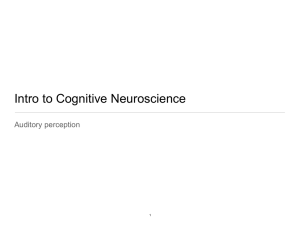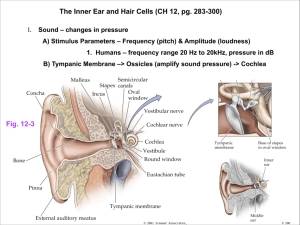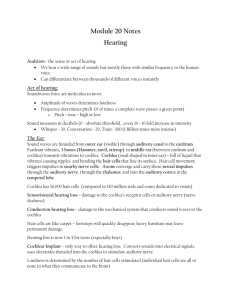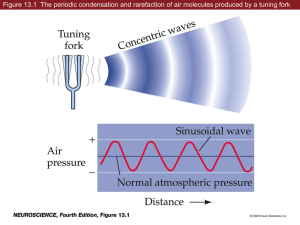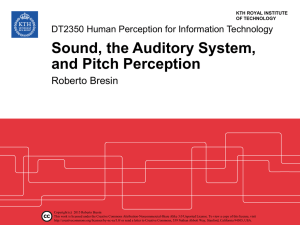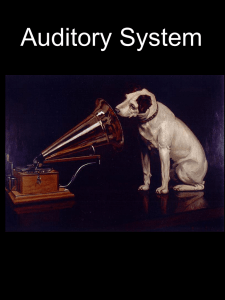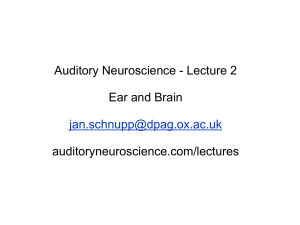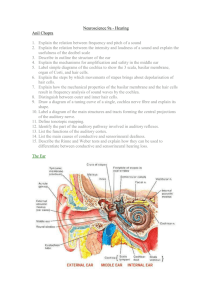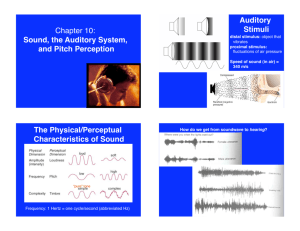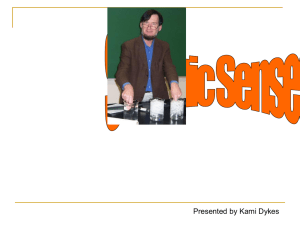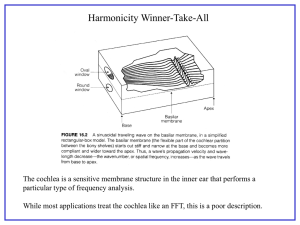The Auditory System
advertisement
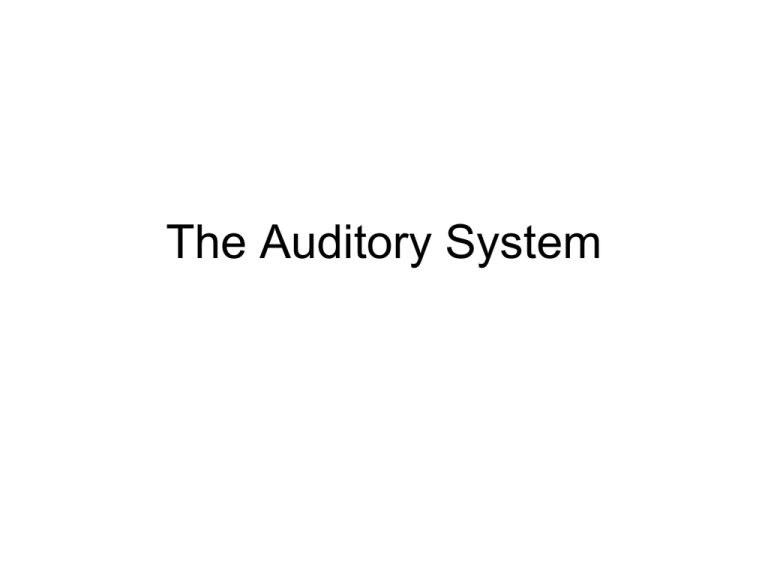
The Auditory System Gross anatomy of the auditory and vestibular systems Tasks of the auditory system • Resolve intensity (loudness) and frequency (pitch, timbre) components of sound stimuli • Localize sound sources in space Delivery of sound energy to the cochlea • Sound consists of pressure waves • The tympanic membrane and auditory ossicles are a mechanism for transferring sound energy from the air medium to the liquid medium of the cochlea • Each sound pressure wave moves the tympanic membrane back and forth, ultimately moving the oval window back and forth. Since liquid in the cochlea is incompressible, movements of the oval window are compensated for by movements of the round window. Frequency segregation in the cochlea – an initial sort of sound frequencies Frequency sorting in the cochlea is the result of a gradient of best resonance frequencies along the length of the cochlea • The best resonance frequency of a structure is the frequency at which it vibrates most readily. This is determined by the shape and material properties of the structure. • Energy transfer between two structures or from a medium to a structure, is most efficient when the energy source delivers vibration at the recipient’s best resonance frequency. Sound Transduction in the cochlea Arrival of a traveling wave causes the basilar membrane to move up and down, bending the stereocilia against the tectorial membrane. This depolarizes the hair cells, leading to transmitter release on the afferent neurons that course into the auditory nerve. Augmentation of sensitivity and frequency resolution at the level of the Organ of Corti • Hair cells are frequency-tuned by virtue of the fact that each hair cell undergoes both electrical and mechanical oscillation at a characteristic frequency: as one passes along the length of the cochlea, the oscillation frequency – and thus the best stimulus frequency - changes incrementally from one hair cell to the next, so that considerable additional frequency resolution takes place after the traveling wave has stimulated the hair cells. Outer hair cells exist mainly to augment vibrations of the basilar membrane • Since stimulated hair cells oscillate more vigorously than unstimulated ones, the having the additional outer cells bouncing on the basilar membrane trampoline causes the membrane movements to have greater amplitude – increasing the stimulus intensity for the inner hair cells, which do connect to afferents. Central Auditory Processing Central auditory pathways Humans use at least two strategies for sound localization • Strategy 1. for frequencies below 3 kHz: phase-locking is possible; time of arrival differences can be detected. The threshold of detection is as small as 10 microsec. This translates to a sensitivity of about 1o of arc. Processing in the brainstem: sound localization by coincidence cells in the olivary nuclei • Q. How can time delays as small as 10 microsec be measured by neurons that have to operate in the msec time domain? • A. The medial superior olive (MSO) receives bilateral inputs from the anteroventral cochlear nuclei. These inputs enter a chain of coincidence cells. Time is measured by conduction time in the network Strategy for higher frequencies • Strategy 2. for higher frequencies, intensity differences between the two ears must be used. At these frequencies, the sound wavelength is so short that the waves cannot bend around the head, so the head creates a sound shadow that enhances the effect. Detection of intensity differences in the brainstem The players here are the lateral superior olive (LSO) and the medial superior nucleus of the trapezoidal body (MNTB). Whichever ear receives the loudest stimulus can also shut off activity in the ascending pathway from the less stimulated ear A map of auditory space is generated by integration of sound localization information in the inferior colliculus • Some neurons in the inferior colliculus respond specifically to: • Sounds coming from particular points in 3D space surrounding the head And also to • Sounds of particular frequencies, or changes in frequency • Sounds of particular duration The primary auditory cortex is a map of the contralateral cochlea In the human brain, a specific area processes speech sounds (Wernicke’s area) A key component of the normal function of this area is analysis of the time sequence of sounds. Most commonly, during early postnatal development the left cortex acquires dominance for spoken language processing. The right cortex then is free to differentiate a specialization in processing musical language. Cortical dominance • The “dominant” cortical half is so-called because it dominates in – motor control, so that the majority of the population are right-handed and right-footed – language control- so that most people prefer to hold the telephone to their right ear, and injury to language related areas (Broca’s A, Wernicke’s A) in the left cortex results in some form of aphasia, whereas damage to the right cortex does not carry the same consequences.
